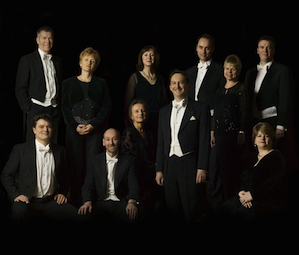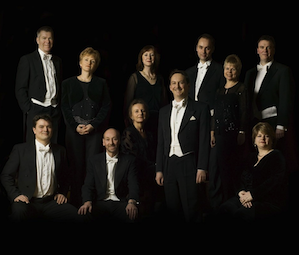
It was 40 years ago that Peter Phillips, then a young music scholar from St. John’s College, Oxford, founded a vocal ensemble that he named after the English composer Thomas Tallis (ca. 1505–1585), to perform choral works from the Renaissance — at that time, virtually uncharted musical territory.
Many concerts and recordings later, the Tallis Scholars have become an institution that is arguably the leading vocal ensemble of Renaissance polyphony, as well as both an example and an inspiration for younger vocal groups all over the world.
The Tallis Scholars are celebrating their 40th anniversary with a world concert tour that started earlier this month at St. Paul’s Cathedral in London. As part of the U.S. leg of their tour, the 10-member ensemble gave two concerts for Cal Performances in Berkeley’s First Congregational Church last weekend.
Any description of the magnificent concert I attended on Saturday will fall short. I lack sufficient superlatives to describe either the ensemble’s astonishing clarity of tone — bright, sometimes steely, but never sharp and with little or no vibrato — or the impeccable way in which the voices blend, perfectly tuned, and are equally suited to both the complexities and details of Renaissance polyphony, as well as the extended sonorities forming the dense layers in the music of Estonian composer Arvo Pärt (b. 1935). It must be a great joy to be able to sing like that.
The Tallis Scholars occasionally venture outside the Renaissance, notably into 20th-century repertoire, though the last time they recorded a contemporary composer was in 1984. For this concert, Phillips — still the group’s director — chose to juxtapose settings of the same liturgical texts by composers that are vastly separated by time.
Any description of the magnificent concert I attended will fall short.
Thus we heard a Magnificat for double choir by 16th-century composer Giovanni Pierluigi da Palestrina, followed by Pärt’s own Magnificat. Music by English Renaissance composer John Taverner (ca. 1490–1545) was heard next to his 20th-century (almost) namesake John Tavener (b. 1944), and the famous Miserere by Gregorio Allegri (1582–1652) contrasted with one of the pieces that the Tallis Scholars commissioned for their anniversary: Sainte-Chapelle, by American composer Eric Whitacre (b. 1970).
With Phillips as a gentle-handed Master Builder, the Tallis Scholars (re)create some superb sonic structures, making Palestrina’s music sound like the inside of a Gothic cathedral. It’s weightless, expansive, and tall, and too overwhelmingly rich for listeners to absorb every detail — though every detail is clearly exposed to the ear.
Palestrina’s setting of Psalm 112, Laudate Pueri (Praise the Lord, ye children), which concluded the concert, contains interweaving melodic lines that choose their own direction, but that gradually converge and culminate in an “Amen” with the appearance of a cathedral column: grounded and solid, yet at the same time slender and graceful.
Contemporary Eloquence
Contemporary composers like Pärt and Tavener create musical architecture that is monumental in a different way: more horizontal and, in Pärt’s case, monolithic. His music shows both its weight and the way it’s constructed very clearly, but there’s no abundance. Pärt’s Nunc Dimittis, which was followed by Palestrina’s motet of the same name, is all about the quality and the beauty of the sound. Vocal lines have little vertical motion, and the music’s eloquence lies in the shifting harmonies that create alternating moments of tension and relaxation.
The Tallis Scholars (re)create some superb sonic structures, making Palestrina’s music sound like the inside of a Gothic cathedral.
Whitacre’s new piece, by contrast, has a different architectural connection. It is inspired by the Sainte-Chapelle in Paris, the 13th-century “Holy Chapel,” commissioned by the French King Louis IX. Whitacre was particularly taken by the enormous, intricate, stained glass windows of the chapel, so he asked a longtime friend, historian Charles Anthony Silvestri (who writes Latin poetry), to create a narrative. The text describes how an innocent young girl enters the chapel and hears the angels depicted in stained glass gently singing the Sanctus.
Sainte-Chapelle is a piece that takes full advantage of the Tallis Scholars’ range and vocal capabilities. It starts like Gregorian chant, with only men’s voices. The women join in at Sanctus, after which the composition changes direction with beautiful, sometimes sharp, chord progressions. After a few subtle twists and turns, it climaxes on a loud “Hosanna in Excelsis” but ends in a beautiful, near-silent “Gloria Tua.”
The concert concluded with a fitting encore from Thomas Tallis himself, in the form of his Loquebantur Variis Linguis — a piece for the feast of Pentecost.

